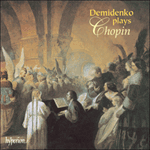
Welcome to Hyperion Records, a British classical label devoted to presenting high-quality recordings of music of all styles and from all periods from the twelfth century to the twenty-first.
Hyperion offers both CDs, and downloads in a number of formats. The site is also available in several languages.
Please use the dropdown buttons to set your preferred options, or use the checkbox to accept the defaults.

| Nikolai Demidenko (piano)» More |
from notes by Ateş Orga © 1992
extrait des notes rédigées par Ateş Orga © 1992
Français: Alain Midoux
aus dem Begleittext von Ateş Orga © 1992
Deutsch: Anne Steeb/Bernd Müller
 Chopin: Demidenko plays Chopin Chopin: Demidenko plays Chopin‘You will be hard pressed to find playing of such super-fine precision and sensitivity. This is undoubtedly one of the most crystalline and exclusive ... ‘Demidenko's free-flowing virtuosity in such comparitive rarities as the Allegro de concert and Tarantella carries all before it, perfectly off ...» More |

